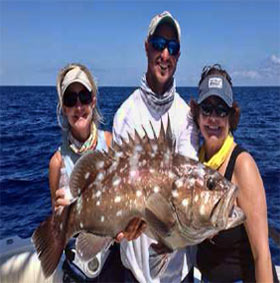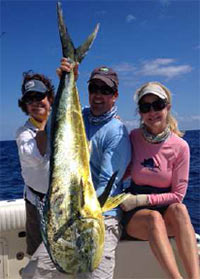April 2014 - Captain's Corner

Springtime is finally here. Actually, it felt like we never had winter here in the keys this season. The nice thing about the springtime fishing in Islamorada is the wide variety of fish you can catch. We’ve been able to really mix up the types of fishing each day. The trick is to take advantage of the weather and currents. We’ve really had to work hard this past month to have good fishing. The biggest reason is the difficulty catching fresh live bait. With the lack of good live bait around, we’ve been doing a lot of deep dropping and patch fishing. The gulf stream has been relatively light inside of 600 ft. This allows us to easily hold bottom with little weight and fish very effectively. We typically use squid or cut up barracuda or skip jack. But, the trick to catching the larger snowy groupers and yellow edge groupers is to use a live bait or deboned ballyhoo.
The biggest surprise the last month was the huge number of sailfish we were finding offshore while we were hunting for dolphin. For nearly two weeks straight, we saw a sailfish with birds working over them. These sailfish were very aggressive too. We caught them on a variety of live baits. The best was a small pilchard. I guess it was mimicking the small baits the sails were feeding on in the weed. I expect the next few months to be a great for sailfish. Then, they migrate down the coast towards Mexico to spawn. The key is to have a current edge that will form a good tailing condition. April is typically a windy month here in south Florida, making the water more turbid. Often, a powder blue color change will form along the outer reef. A variety of pelagic fish will surf the waves as they travel west down the coast. The local fishing captains love to sight fish for sailfish and cobia this time of year. The powder blue water makes it super easy to spot the migrating fish as the surf the waves. Some of my best days as a captain have occurred with the springtime tailing condition. It is important to take advantage of a good color change when we have one.
 The humps have also been very active for tuna and amberjacks. The early morning and late afternoon bite is usually the most productive for the tuna fishing. The key to catching an amberjack is usually the bait. A live blue runner or goggle eye work well for bait, however a deboned tuna or bonita really catch the big sea donkeys. And don’t be disappointed if a big shark decides to munch on your amberjack. Its not unusual for a big tiger or hammerhead shark this time of year to have an easy meal.
The humps have also been very active for tuna and amberjacks. The early morning and late afternoon bite is usually the most productive for the tuna fishing. The key to catching an amberjack is usually the bait. A live blue runner or goggle eye work well for bait, however a deboned tuna or bonita really catch the big sea donkeys. And don’t be disappointed if a big shark decides to munch on your amberjack. Its not unusual for a big tiger or hammerhead shark this time of year to have an easy meal.
The best bet for the next month will be the permit on the wrecks, along with the appearance of the slammer dolphin. Historically, some of the biggest bulls are caught over the next 2 months. More often than not, they will be caught under a frigate bird that is feeding on the flying fish which the dolphin are scaring into the air. The yellowtail snapper fishing is also outstanding over the next few months when the water is churned up. The muddier water helps camouflage your line so you in turn get more bites.
